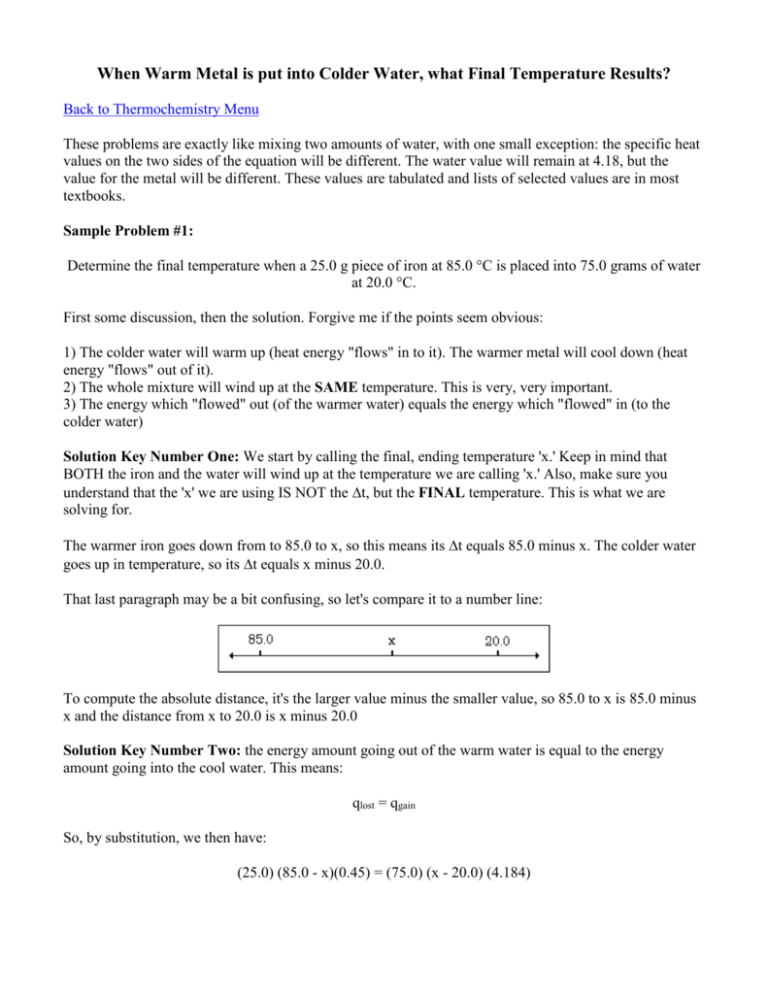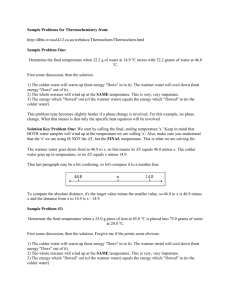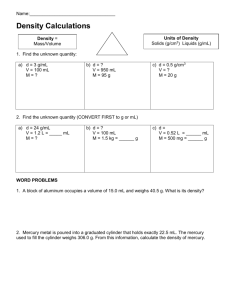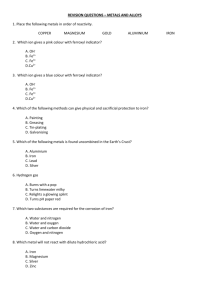When Warm Metal is put into Colder Water, what Final Temperature
advertisement

When Warm Metal is put into Colder Water, what Final Temperature Results? Back to Thermochemistry Menu These problems are exactly like mixing two amounts of water, with one small exception: the specific heat values on the two sides of the equation will be different. The water value will remain at 4.18, but the value for the metal will be different. These values are tabulated and lists of selected values are in most textbooks. Sample Problem #1: Determine the final temperature when a 25.0 g piece of iron at 85.0 °C is placed into 75.0 grams of water at 20.0 °C. First some discussion, then the solution. Forgive me if the points seem obvious: 1) The colder water will warm up (heat energy "flows" in to it). The warmer metal will cool down (heat energy "flows" out of it). 2) The whole mixture will wind up at the SAME temperature. This is very, very important. 3) The energy which "flowed" out (of the warmer water) equals the energy which "flowed" in (to the colder water) Solution Key Number One: We start by calling the final, ending temperature 'x.' Keep in mind that BOTH the iron and the water will wind up at the temperature we are calling 'x.' Also, make sure you understand that the 'x' we are using IS NOT the t, but the FINAL temperature. This is what we are solving for. The warmer iron goes down from to 85.0 to x, so this means its t equals 85.0 minus x. The colder water goes up in temperature, so its t equals x minus 20.0. That last paragraph may be a bit confusing, so let's compare it to a number line: To compute the absolute distance, it's the larger value minus the smaller value, so 85.0 to x is 85.0 minus x and the distance from x to 20.0 is x minus 20.0 Solution Key Number Two: the energy amount going out of the warm water is equal to the energy amount going into the cool water. This means: qlost = qgain So, by substitution, we then have: (25.0) (85.0 - x)(0.45) = (75.0) (x - 20.0) (4.184) Solve for x Please note the use of the specific heat value for iron. It is 0.45 J per gram degree Celsius. Noting that 75/25 = 3, we arrive at: 38.25 - 0.45x = 12.552x - 251.04 then 13.002x = 289.29 The answer is 22.25 °C if you aren't too fussy about significant figures. Note that the iron drops quite a bit in temperature, while the water moves only a very few (2.25 in this case) degrees. This is the typical situation in this type of problem. Sample Problem #2: Determine the final temperature when 10.0 g of aluminum at 130.0 °C mixes with 200.0 grams of water at 25.0 °C. There is no difference in calculational technique from sample problem #1. Please note the starting temperature of the metal is above the boiling point of water. In reality, the sample may vaporize a tiny amount of water, but we will assume it does not for the purposes of the calculation. Here are the numbers: (10)(130 - x)(0.901) = (200.0)(x - 25)(4.18) Noting that 200/10 = 20, I get: 117.13 - 0.901x = 83.6x - 2090 and so, x = 26.12 °C. Keep in mind that 'x' was identified with the final temperature, NOT the t. Also, I did this problem with 4.18. Doing it with 4.184 gives a slightly different answer. Make sure you check with your teacher as to the values of the various constants that he/she wishes for you to use. Sample Problem #3: Determine the final temperature when 20.0 g of mercury at 165.0 °C mixes with 275.0 grams of water at 60.0 °C. (Cp for Hg = 0.14 J per gram degree Celsius.) [By the way, we will ignore the fact that mercury is liquid. It so happened that iron, aluminum and mercury were the three specific heats given in the textbook I used. So there!] The answer is here. Back to Thermochemistry Menu http://dbhs.wvusd.k12.ca.us/ || Copyright © 2004 by John L. Park







![Toxicology[1]](http://s3.studylib.net/store/data/007752206_2-b566ca3edffa0c85b4a94406330f856d-300x300.png)